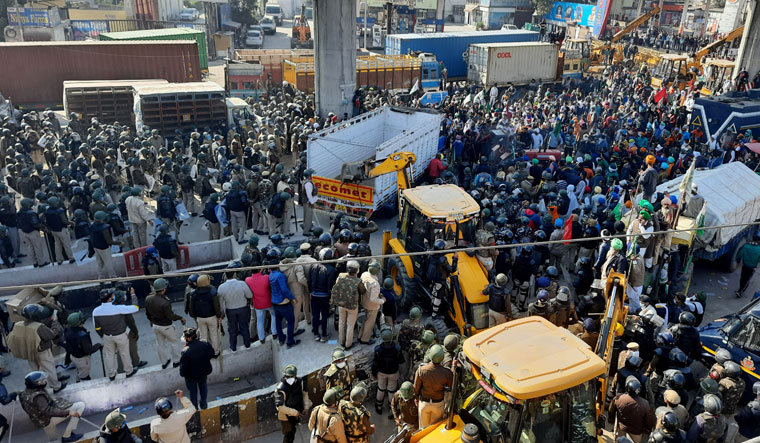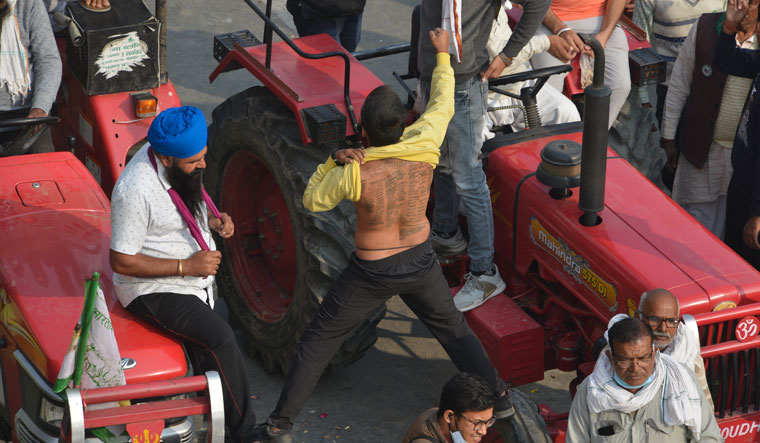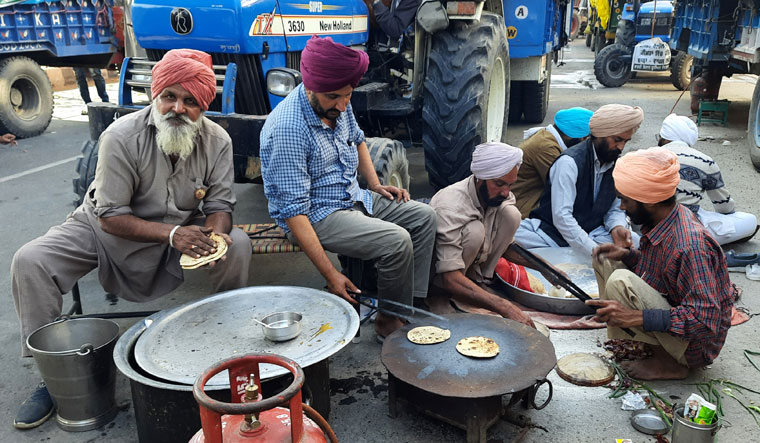Mohinder Singh’s enthusiasm belies his age. His weather-beaten face speaks of the struggles he has gone through—from surviving crop failure to participating in various movements Punjab has seen over the decades. This one, he hopes to win.
The 78-year-old farmer from Punjab’s Fatehgarh Sahib district is camping near the Singhu border, Delhi’s main gateway to Haryana and Punjab. He wants the Union government to withdraw the three agriculture reform laws it had passed in September. “The Central government wants to take away our land and destroy us. The laws must be withdrawn,” said Singh, as he sat with his friends near a tractor trolley, peeling garlic cloves for an evening meal.
On both sides of the six-lane Grand Trunk Road are seemingly endless rows of tractors and trolleys blocking the Singhu border. For every five tractors, there is a trolley full of ration and essential supplies. The farmers have set up makeshift street-kitchens for anyone who cares to join them. Delhi’s powerful gurdwara body has pitched in with its own langar (community kitchen), and so have other organisations like Khalsa Aid. People from Haryana are supplying bottled water, milk, gas cylinders, mattresses and blankets.
The scene resembles a mini city built by a caravan of migrants, or an army division waiting for its next order. The farmers have already travelled more than 300km, crossing barriers put up by the police in Haryana and Delhi, and braving tear gas and water cannons. The Punjab peasantry’s cultural history of resistance against those in power in Delhi has provided energy to the movement.
Also, they are in it for the long haul. If the negotiations fail, they are well-prepared to ride out Delhi’s harsh winter. The line of protesters runs up to 10km by some accounts, and is growing by the day as farmers from Haryana and Uttar Pradesh join in. Parallels can be drawn to the farmer agitation in 1988, when Mahendra Singh Tikait of Uttar Pradesh led protesters to the India Gate lawns.
As the first round of talks failed to make headway, the siege of Delhi spread to other border points. The government’s offer to allow farmers to protest from the Nirankari grounds in Delhi was a faux pas. The farmers are predominantly Jat Sikhs who in the past have had a long and violent feud with the Nirankari sect, an offshoot of Sikhism that installed a living guru as its chief. The farmers refused to go there saying it will be an open jail, and stayed put at the border instead.
“We have already lighted diyas during Diwali, wished our families goodbye. They said, ‘We will wait for you, but more important is that you return victorious. For the cause, even if you don’t return, we will accept that,’” said Jaskaran Singh of Faridkot, overcome with emotion. Singh’s sentiment is shared by fellow protesters as they continue to gather at Delhi’s doorsteps.
The Union government will find it hard to wish the anger away. Last December, protests against the Citizenship (Amendment) Act began gathering momentum. As Shaheen Bagh model gatherings spread across the country, the Union government, and states where the BJP was in power, cracked down on the protesters. But it was the Covid-19 pandemic that dealt a severe blow to the anti-CAA protests. As farmers are a far more politically sensitive constituency, and the lockdown having ended, the Union government would find it hard to deal with the protesters.
At heart of the issue is the government’s decision to introduce three key legislations that demolish socialist-era structures built when food security was a major concern. Before the reforms, farmers could sell their produce only through agriculture produce market committees (APMCs). Farmers in Punjab, Haryana and Uttar Pradesh sold paddy and wheat through APMC mandis to get the government-approved minimum support price. The new laws allow farmers to sell their produce outside mandis to anyone, anywhere and anytime. “This will enable farmers to get a price for their produce that is higher than the MSP, thus helping farmers double their income,” said Union Agriculture Minister Narendra Tomar.
The other two laws—on contract farming and amending the Essential Commodities Act—were to facilitate the entry of corporate players in the farm sector to generate growth and employment. These moves made farmers anxious, especially in Punjab, where rabi and kharif crops sold outside the APMC mandis fetched lower prices. Also, a 2015 report had recommended that the government scale down procurement and replace the public distribution system with cash transfers. This would mean lesser procurement by the Food Corporation of India, thus removing the cushion of assured MSP for farmers.
“The MSP for paddy is Rs1,888 per quintal,” said Balbir Singh Rajewal, president of the Bharatiya Kisan Union (BKU) in Rajewal, Punjab. “But in Bihar, where APMC mandis are not there, it is getting sold below Rs900. The same lot is being sold in Punjab for Rs1,000. This amply shows that if the government exits [the procurement process], farmers will not get an assured price. In the case of maize, the MSP is Rs1,800; but we don’t get more than Rs800 as the government does not buy [enough]. We don’t get value for our lentils. We import lentils and oil at a huge cost, but the government is not ready to pay us.”
Rajewal and 30 other farmer leaders from Punjab met Tomar and Commerce Minister Piyush Goyal to find a solution. But the government, which had initially dismissed the agitation as being limited to the Congress-ruled Punjab, seems determined to implement the laws, even though farmers in Haryana and Uttar Pradesh have joined in the protests. Sources said the laws would not be withdrawn, since Prime Minister Narendra Modi has repeatedly stressed its far-reaching impact and described the protests as misguided.
The government’s plan is to deal with farmer groups from different regions separately, and try to pin down the grievances limited to that region. Tomar is trying to strike a deal by assuring farmers that MSP would stay. Farmers, however, are adamant on a written assurance.
“The MSP was enforced through an administrative order, and not a law, since 1965. Then why the need for a legal provision now?” asked Iqbal Singh Lalpura, BJP’s newly appointed national spokesperson and the first Sikh to be elevated to the post. “The farmers were made apprehensive by vested political interests. The apprehension is that something bad can happen in the future. They are going by a false narrative.”
Lalpura said the agitation was a political movement supported by farmers. “The issue was taken up by the Congress and the Shiromani Akali Dal in Punjab for their political gains. Farmers joined them later. They [political parties] misguided the farmers. The prime minister and agriculture minister assured on the floor of [Parliament] that the MSP will stay.”
The Congress, the SAD and the Aam Aadmi Party, which have stakes in Punjab, have supported the agitation, but the protesters have not allowed politicians to occupy their platform. The BJP government in Haryana is facing heat as Jats, who did not vote for the party in the last elections, are restless. The khap panchyats in the state have pledged support to their “elder brothers”, the Punjabi farmers. Along with them, moving in to block Delhi’s other border points are farmers from Haryana and UP, led by Tikait’s son Rakesh Tikait. It will need deft handling on the part of the Centre to arrive at a solution.
“No political party will be allowed to speak from our stage,” said Jagmohan Singh, BKU general secretary in Dakaunda, Punjab. “Here, party divisions have ceased to exist, as people from all over have joined in this struggle. Our demand is that the government withdraw the three laws, propose [a new] electricity bill, and make references to the agriculture sector in the pollution guidelines.”
What has made this protest politically potent is the attention and support it is drawing from Punjab, particularly from the Sikh community. Punjab’s farmers are mostly Jat Sikhs who have presence in governance structures and the armed forces. They are receiving support from Punjabi artists, sportspersons and personalities, who have huge followings. This has made the agitation a community struggle, with the Punjabi diaspora pitching in with emotional and material support.
Sensing the polarisation, the government has begun crisis management. A 44-page booklet, titled ‘PM Modi and his government’s special relationship with Sikhs’, was released listing the steps taken since Modi’s days as Gujarat chief minister—removing taxes on langars, opening of the Kartarpur corridor, building infrastructure for Sikh shrines, and ensuring justice for the victims of the 1984 riots.
Many BJP leaders say radical elements have infiltrated the agitation, but protesters deny it. “Youths here are holding placards saying that we are farmers, and not terrorists,” said Jagjit Singh Dalewal, general secretary of BKU in Sidhupur. “The BJP earlier said it is only a Punjab-centric movement, but now you see farmers from Madhya Pradesh, Rajasthan and even Kerala. It is a nationwide movement.”
The non-violent nature of the agitation has attracted a great deal of attention. “Our youth are naturally aggressive, but this is the first time they understood that if this battle has to be won, they have to stay non-violent,” said Rajewal. “That if they turned violent, the movement will fail. There was lathi-charge, water cannon and tear gas, yet the people remained non-violent.”
Activist Medha Patkar, who visited the Singhu border, said the mass mobilisation was unprecedented. “Generally, when issues related to agriculture are raised, there is a division between farmers as landowners and land labourers,” she said. “But here is the widest possible unity, as it has brought everyone together. They are going to test the Modi government.”
Shiv Kumar Kakka, farmer leader from Madhya Pradesh, said the government should cede to the demands. “In the last six and a half years, the Modi government has brought 18 laws against farmers, and 32 laws against workers. All these acts make sure that one cannot move the courts. The prime minister should have a big heart and agree to all the demands of the farmers.”




